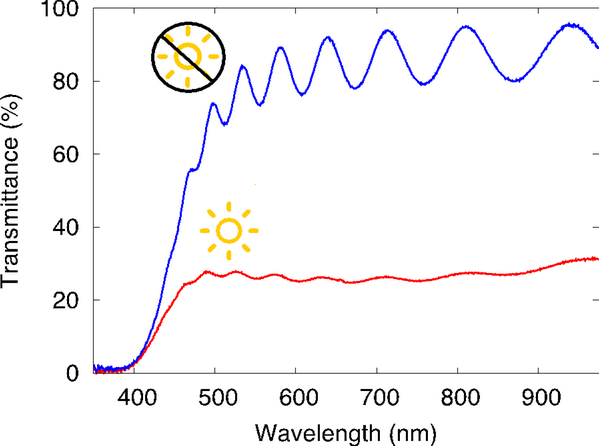Chromogenic materials
Research
The Division of Solid State Physics is well-known for its work on chromogenic materials, in particular electrochromics, which was researched by Claes Göran Granqvist and Gunnar A. Niklasson for many years [1-4]. The work on thermochromics [5] has led to the coining of the new sub-field of nanothermochromism [6], which Österlund’s group is expanded into the growing field of nanochromics and multichromics, to include also new pioneering work on photochromics [7-11]. Rare earth photochromic oxyhydrides are T-type, positive photochromic materials that darken under irradiance with blue or UV light (Fig. 2), where the transmittance of an YHO film before and after illumination is presented as a function of wavelength. The change in the optical properties is reversible. Such photochromic materials can be fabricated as explained above, from a YH2 thin film precursor and without intentional substrate heating, enabling the fabrication onto flexible substrates.
The work on electrochromics have spun off the company Chromogenics AB, which today produces electrochromic foils in roll-to-roll processes. The UU group work closely with Chromogenics in several R&D projects and uses the R&D roll-to-roll sputter facility situated at Chromogenics.

Figure 2: Transmittance in the clear (non-illuminated) and dark (under illumination) states corresponding to an YHO film (1 mm-thick). Adapted from reference 18.
References
14] Editor’s Suggestion, Physics, American Physical Society (2020), Synopsis: “Breathing” Explains Light-Induced Darkening. Online: https://physics.aps.org/articles/v13/s22.
[15] M. A. Arvizu et al., Electrochromic WO3 thin films attain unprecedented durability by potentiostatic pretreatment. Journal of Materials Chemistry A, 7(6), 2908-2918 (2019).
[16] J. Montero, F.A. Martinsen, M. Lelis, S.Z. Karazhanov, B.C. Hauback, E.S. Marstein, Preparation of yttrium hydride-based photochromic films by reactive magnetron sputtering, Sol. Energy Mater. Sol. Cells. 177 (2018) 106–109.
[17] E.M. Baba, J. Montero (corr.), E. Strugovshchikov, E.Ö. Zayim, E.Z. Karazhanov, Light-induced breathing in photochromic yttrium oxy-hydrides, Phys. Rev. Mater. 4 (2019) 25201.
[18] J. Montero, S.Z. Karazhanov, Spectroscopic Ellipsometry and Microstructure Characterization of Photochromic Oxygen-Containing Yttrium Hydride Thin Films, Phys. Status Solidi Appl. Mater. Sci. 1701039 (2018) 1–7.
[19] Wen, R. T., Granqvist, C. G., & Niklasson, G. A. (2015). Eliminating degradation and uncovering ion-trapping dynamics in electrochromic WO3 thin films. Nat. Mater., 14(10), 996-1001.
[20] G.B. Smith, C.G. Granqvist, Green Nanotechnology, CRC Press, Boca Raton, FL (2011).
[21] C.-G. Granqvist, A. Azens, P. Heszler, L. B. Kish, and L. Österlund, New Nanomaterials for Energy Efficient Buildings: Electrochromics for “Smart Windows”, Sensors for Air Quality, and Photo-Catalysts for Air Cleaning., In: Nanomaterials New Research Developments, Eds: E. I. Pertsov, Nova Science Publ (2008). ISBN: 978-1-61668-072-5. diva2:318914.
[22] Li, S. Y., Niklasson, G. A., & Granqvist, C. G. (2012). Thermochromic fenestration with VO2-based materials: Three challenges and how they can be met. Thin Solid Films, 520(10), 3823-3828.
[23] Li, S. Y., Niklasson, G. A., & Granqvist, C. G. (2010). Nanothermochromics: calculations for VO2 nanoparticles in dielectric hosts show much improved luminous transmittance and solar energy transmittance modulation. J. Appl. Phys., 108(6), 063525.
